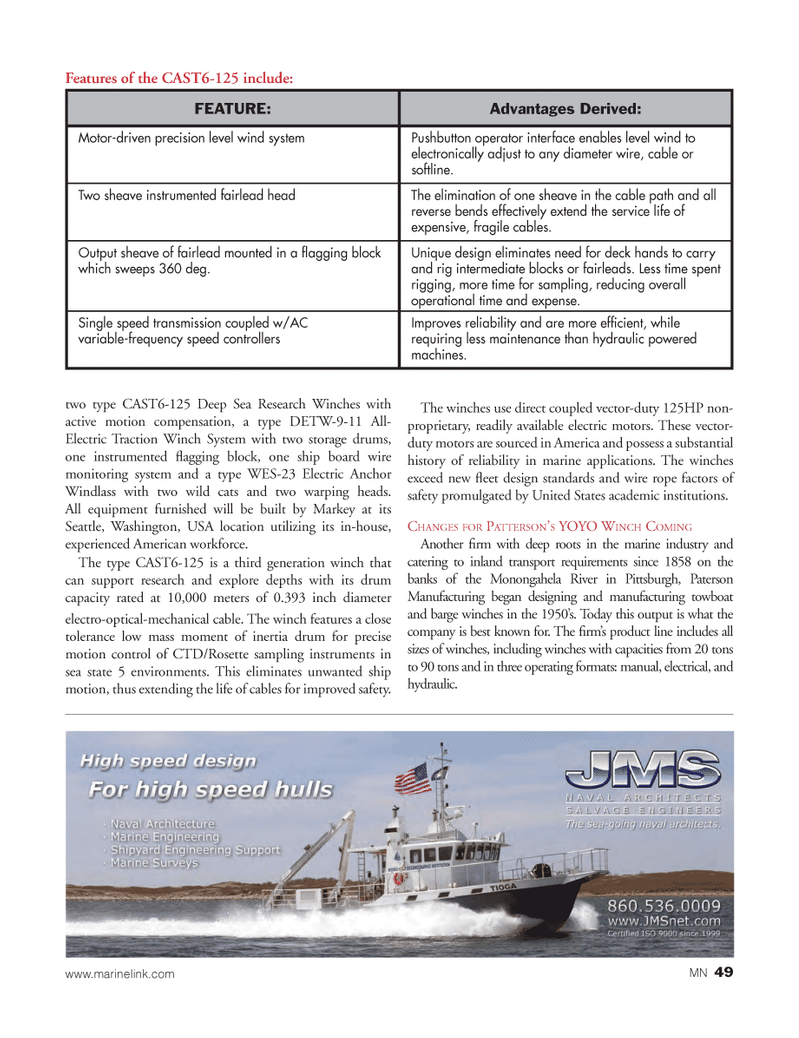
Page 49: of Marine News Magazine (July 2012)
Propulsion Technology
Read this page in Pdf, Flash or Html5 edition of July 2012 Marine News Magazine
Features of the CAST6-125 include: FEATURE: Advantages Derived:Motor-driven precision level wind systemPushbutton operator interface enables level wind to electronically adjust to any diameter wire, cable or softline. Two sheave instrumented fairlead head The elimination of one sheave in the cable path and all reverse bends effectively extend the service life of expensive, fragile cables. Output sheave of fairlead mounted in a ß agging block which sweeps 360 deg.Unique design eliminates need for deck hands to carry and rig intermediate blocks or fairleads. Less time spent rigging, more time for sampling, reducing overall operational time and expense.Single speed transmission coupled w/AC variable-frequency speed controllersImproves reliability and are more efÞ cient, while requiring less maintenance than hydraulic powered machines. two type CAST6-125 Deep Sea Research Winches with active motion compensation, a type DETW-9-11 All- Electric Traction Winch System with two storage drums, one instrumented ß agging block, one ship board wire monitoring system and a type WES-23 Electric Anchor Windlass with two wild cats and two warping heads. All equipment furnished will be built by Markey at its Seattle, Washington, USA location utilizing its in-house, experienced American workforce. The type CAST6-125 is a third generation winch that can support research and explore depths with its drum capacity rated at 10,000 meters of 0.393 inch diameter electro-optical-mechanical cable. The winch features a close tolerance low mass moment of inertia drum for precise motion control of CTD/Rosette sampling instruments in sea state 5 environments. This eliminates unwanted ship motion, thus extending the life of cables for improved safety. The winches use direct coupled vector-duty 125HP non- proprietary, readily available electric motors. These vector- duty motors are sourced in America and possess a substantial history of reliability in marine applications. The winches exceed new ß eet design standards and wire rope factors of safety promulgated by United States academic institutions. CHANGES FOR PATTERSON ÕS YOYO W INCH COMINGAnother Þ rm with deep roots in the marine industry and catering to inland transport requirements since 1858 on the banks of the Monongahela River in Pittsburgh, Paterson Manufacturing began designing and manufacturing towboat and barge winches in the 1950Õs. Today this output is what the company is best known for. The Þ rmÕs product line includes all sizes of winches, including winches with capacities from 20 tons to 90 tons and in three operating formats: manual, electrical, and hydraulic. www.marinelink.com MN 49

 48
48

 50
50
